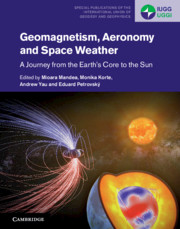Book contents
- Geomagnetism, Aeronomy and Space Weather
- Special Publications of the International Union of Geodesy and Geophysics Series
- Geomagnetism, Aeronomy and Space Weather
- Copyright page
- Contents
- Contributors
- Preface
- Part I Introduction
- Part II Geomagnetic Field
- Part III Spatial and Temporal Variations of the Geomagnetic Field
- Part IV Space Weather
- 14 Physical Processes of Space Weather
- 15 Space Weather Effects in the Ionosphere, in the Thermosphere and at Earth’s Surface
- 16 Technological Impacts of Space Weather
- Part V Magnetic Fields beyond the Earth and beyond Today
- Index
- References
15 - Space Weather Effects in the Ionosphere, in the Thermosphere and at Earth’s Surface
from Part IV - Space Weather
Published online by Cambridge University Press: 25 October 2019
- Geomagnetism, Aeronomy and Space Weather
- Special Publications of the International Union of Geodesy and Geophysics Series
- Geomagnetism, Aeronomy and Space Weather
- Copyright page
- Contents
- Contributors
- Preface
- Part I Introduction
- Part II Geomagnetic Field
- Part III Spatial and Temporal Variations of the Geomagnetic Field
- Part IV Space Weather
- 14 Physical Processes of Space Weather
- 15 Space Weather Effects in the Ionosphere, in the Thermosphere and at Earth’s Surface
- 16 Technological Impacts of Space Weather
- Part V Magnetic Fields beyond the Earth and beyond Today
- Index
- References
Summary
In the context of space weather effects, magnetosphere-ionosphere coupling is one of the fundamental processes controlling energy transfer and dissipation in geospace. Alfvén waves appear to play a key role in this coupling, specifically in coupling the dynamics of magnetospheric convection to the ionosphere and in generating the region 1 and region 2 global field-aligned current systems. The momentum transport from the magnetosphere to the ionosphere can be described as the result of the generation and propagation of Alfvén waves, for example as arising along newly reconnected magnetic field-lines, and in general in terms of their incidence on and reflection from the ionosphere. The thermosphere experiences dramatic changes in density and composition during magnetic storms. Intense Joule heating and particle precipitation at auroral latitudes cause intense thermal expansion, air upwelling and strong wind circulations. The Joule heating at E-layer altitudes can cause both density enhancements and depletions at higher altitudes, and complicate the interpretation of mass density anomalies at high latitudes. The thermospheric response to storms at middle and low latitudes is less complicated, where the averaged density enhancement is linearly proportional to the solar wind input. Magnetic substorms during active periods also cause mass density perturbations. Magnetic storms and substorms can cause disturbances up to thousands of nT at the Earth’s surface. The time derivative of the magnetic field provides a proxy for the associated geoelectric field, which can drive geomagnetically induced currents in Earthed conductors. The geoelectric field is thus a key quantity for space weather effects on technological systems such as power grids, and it can be obtained by modelling the magnetic field using ionospheric currents and model ground conductivity as inputs.
Keywords
- Type
- Chapter
- Information
- Geomagnetism, Aeronomy and Space WeatherA Journey from the Earth's Core to the Sun, pp. 229 - 250Publisher: Cambridge University PressPrint publication year: 2019



